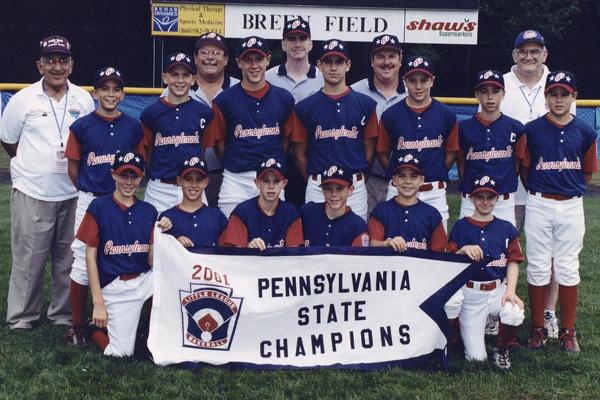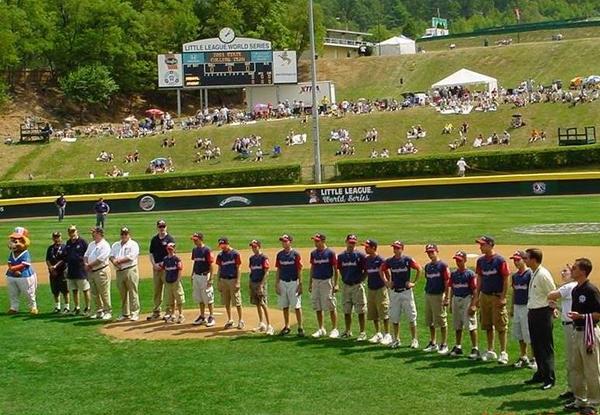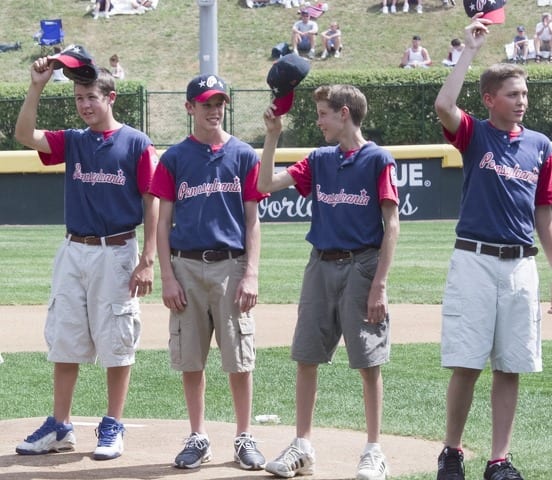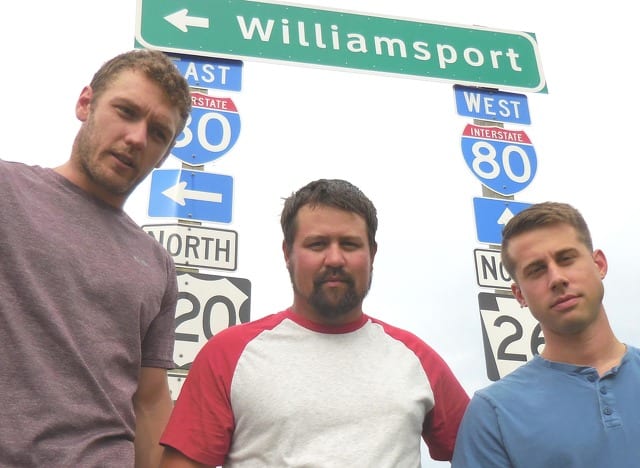Williamsport, Pa. has little in common with Rio de Janeiro, that’s for sure. But for the next few days, sports lovers will click between the Rio of NBC’s Olympics and the “Billtown” of ESPN’s Little League World Series.
As an old Little Leaguer from the 1960s, I’ll follow the action from Williamsport. Maybe you’ll do the same. But a group of young men who grew up in State College — now in their 20s — can be forgiven if they prefer to watch something that doesn’t remind them of the Little League World Series.
It has been 15 years since the State College American Little League All Stars missed out on a dream — a chance to play on Little League’s biggest stage. Their disappointment stemmed not from a failure at bat or in the field. Rather, they were denied a trip to Williamsport when a team from New York City put an over-aged pitcher on the mound in the finals of the Mid-Atlantic Region.
Danny Almonte threw a no-hitter against the boys from Happy Valley, striking out 16 batters. He allowed only two base runners in a 2-0 victory — Chad White got aboard with a walk and also took base when hit by a pitch. Meanwhile, rumors had been swirling around the regional tourney in Bristol, Conn., suggesting that Almonte and some of his Rolando Paulino Little League teammates were older than the maximum age of 12.
 Happy state champs: Front row, from left–Leon Harner, Ken Farnsworth, Philip Horne, Chad White, Brendan Pifer and Patrick Northup-Moore. Middle row–Joe Gazza, Brook Hart, Shane Gray, Doug Suhey, Tyler Mincemoyer, Andrew Kerr, Travis Tice. Back row–Uncle Dan, Coach Mike White, Manager Tom Hart, Coach Tom Mincemoyer, Uncle Paul. (The “uncles” were volunteers in Bristol who assisted each team.) Photo provided by Tom Mincemoyer.
Happy state champs: Front row, from left–Leon Harner, Ken Farnsworth, Philip Horne, Chad White, Brendan Pifer and Patrick Northup-Moore. Middle row–Joe Gazza, Brook Hart, Shane Gray, Doug Suhey, Tyler Mincemoyer, Andrew Kerr, Travis Tice. Back row–Uncle Dan, Coach Mike White, Manager Tom Hart, Coach Tom Mincemoyer, Uncle Paul. (The “uncles” were volunteers in Bristol who assisted each team.) Photo provided by Tom Mincemoyer.
‘THE GUY NEEDED A RAZOR’
The coach of another team claimed to have evidence of age violations. Disgruntled parents of Rolando Paulino players said their coach was fielding ineligible athletes. And then there was the “eye test” administered by State College parents. “I saw Almonte with a few of his buddies,” says Bill Gray, the father of outfielder Shane Gray, “and I remember thinking the guy needed a razor and that he should shave before the next game.”
State College American’s manager, Tom Hart, asked regional officials to investigate, but they declined, and there wasn’t enough time to track down the evidence. Having vanquished State College, Almonte went on to Williamsport where he grabbed national attention by throwing a perfect game and a one-hit shutout. Almonte couldn’t pitch every game, however, and his team settled for third place in the U.S.
That’s where things stood until Sports Illustrated examined records in Moca, the city in the Dominican Republic where Almonte was born. Almonte’s original birth certificate was found, and it carried a birth date of April 7, 1987—not 1989 as a fraudulent copy had shown. It seems the left-hander was 14-years-old during the 2001 playoffs. No wonder he and his near-adult arm were blowing away hitters from the Little League pitching distance of 46 feet.
A TITLE AND MORE PAIN
Little League issued a “disqualification” of the Rolando Paulino team on Sept. 1 — two weeks after completion of the Williamsport championships. All previous victories were vacated, and State College was officially named the Mid-Atlantic champion. But if anything, the confirmation of cheating just added to the pain felt by State College players.
“It was heart-breaking,” says Ken Farnsworth, who was the only 11-year-old on the team. “To think that we lost in a game that wasn’t even fair was hard to swallow. I remember throwing a baseball in my room and putting a hole in the wall.”
“I felt sad that we didn’t get a chance to go play against the best in the world,” recalls Shane Gray.
“I felt like I lost almost everything that we worked for,” says Travis Tice. “At our very first practice, the coach said it was up to us how hard we wanted to work and what our ultimate goal was. And just like every 11- or 12 year-old, we said, ‘We want to play in the Little League World Series.‘ We were one step away and it got ripped out from underneath us.”
“When it became official,” says Brook Hart, a key player and son of the team’s manager, “it just stung that much more. To think of realizing that childhood dream of playing in the Little League World Series right down the road from your hometown where you would have been in front of 30,000 or 40,000 people…”

Bittersweet day: State College players were recognized during the 2002 Little League World Series as the rightful Mid-Atlantic champions from the previous year. Photo provided by Tom Mincemoyer.
* * *
Keystone Little Leaguers from Clinton County have enjoyed the very opportunity envisioned by Brook Hart. In 2011, they qualified for the World Series, played well and drew a record 41,848 fans for one of their games. Keystone almost made a repeat appearance this year, losing 6-2 in the Mid-Atlantic championship game.
But for State College, a geographical irony remains. Williamsport is a mere 60 miles from this community, yet most Little Leaguers here would tell you that “making it to Williamsport” feels like a trek to the other side of the globe.
“It’s the pinnacle,” says Eric Gulley, manager for the 2016 All Stars who represented the State College Little League. “It’s the gold standard.” No wonder, then, that the painful memory of 2001 is still felt occasionally. “When Keystone made their run a couple years ago,” says Gulley, “I remember people saying, ‘That could have been us, but that was ripped away from us.’ “
* * *
According to Tom Mincemoyer, one of the team’s coaches, the boys of 2001 showed their potential at a young age. “In Tee Ball (for five- and six-year-olds),” says Mincemoyer, “people would say ‘Wow!’ if you got an out on defense. But three of these kids turned a double play on a ground ball — Doug Suhey, Brendan Pifer and my son, Tyler Mincemoyer.”
A few years later, this talented group won the Pennsylvania Little League championship for 9- and 10-year-olds — the highest achievement possible at that age. Their fathers began thinking about getting to Williamsport, maybe winning it all. “They were athletically gifted,” notes Mincemoyer, “really something special. Of course, every great team has a superstar player, and that was Doug Suhey. And he was the best player by a lot.” Adds Tom Kerr, father of second baseman Andrew Kerr, “Doug wasn’t just a dominating pitcher; he was hitting homers all over the place.”
After the team won the 10-year old title, Mincemoyer and Suhey’s dad, Larry, (former state champion wrestler and all state football player at State High) asked Hart if he would coach the team. They got a “yes” — with a few stipulations.
“If I’m the coach,” said Hart, “we will do it my way. We’ll do fundamentals, fundamentals, fundamentals, and when the kids get sick of those, we’ll do them again.” True to his word, Hart drilled the team relentlessly. Says Andrew Kerr, “I would be shocked if other kids our age were doing two-a-day practices.”
Hart certainly did teach fundamentals through grueling practices, but he added some creative touches. Even after 15 years, his players all recall:
-
Unwashed practice shirts. The players wore the same t-shirts to every practice from early July to mid-August, with nary a visit to the washing machine. The grass stains and dirt smudges on once-white shirts reminded them of their hard work, and each player’s shirt bore the name of an animal — used by Hart as code during games to call defensive plays.
-
Off-site warmups. At a typical baseball game, each team takes its turn at “infield” — a pregame defensive warmup. But Hart’s players would warm up at an off-site field so opponents couldn’t study their tendencies. The tactic also provided a major “psych-out” when State College would suddenly appear at the game, ready to play.
-
“Feed the bird.” Hart was a State College policeman, and he had become accustomed to a particular gesture when officers returned safely from a hazardous call. At such a time, the policemen would congratulate each other by “feeding the bird.” And so his Little Leaguers did the same, celebrating a big play with a quasi-handshake that used three fingers to mimic the pecking of a bird’s beak. These days, it serves as a special greeting when teammates meet.
-
An inspirational figure. Patrick Northrup-Moore, slightly older than the boys on the team, served as “honorary captain.” Born with some physical limitations, Patrick constantly offered encouragement. He was, in fact, usually the first to “feed the bird” after a big hit or defensive play. Today, he offers similar inspiration to the Penn State men’s basketball team.
Blessed with talent, guided by a tough and crafty manager, encouraged by each other, the State College American League All Stars expected success. “We were supposed to win every game,” notes Andrew Kerr. “That was part of the culture.”
Indeed, once the loss to Almonte’s team was overturned, State College sported a season record of 16-1. The only official loss was meaningless — it came in the first round of Mid-Atlantic Regionals when the team had already qualified for the next round. Perhaps the best indicator of State College’s power was its 16-0 mauling of Milton in the Pennsylvania championship game.
But Hart was not only focused on the baseball diamond. He wanted his players to develop strong character, so he would talk about values. He wanted them to become good citizens, so he gave instruction about proper conduct during the playing of “The Star Spangled Banner” — standing at attention, holding their hats over their hearts, no chewing gum, no laughing.

Receiving overdue cheers: Shown from left during 2002 ceremony are Travis Tice, Philip Horne, Leon Harner and Brook Hart. Photo provided by Little League headquarters in Williamsport.
THEIR GREATEST LESSON
Little did Hart know that his team’s greatest character lesson would be brought about by circumstances beyond his control. That lesson began immediately after Danny Almonte got the last out in Connecticut. State College players were crying and struggling with anger. But their manager called them together and said that, no matter what they had heard about the other team, they were going to show respect for their win. And then, says Shane Gray, “Mr. Hart had us go out on the field and clap for the other team. It was a character thing.”
The lesson of dealing with disappointment continued when the players were invited to Williamsport during the 2002 World Series to be recognized as the official 2001 Mid-Atlantic champions. Although it was a thoughtful gesture on the part of Little League officials, it also reminded the players of all that had been denied to them through an injustice.
And so now these “boys” are men in their 20s. Hart played football and baseball at Yale, Kerr played football at Princeton, Suhey played football at Cornell and then served his country in the Middle East during two military deployments. All 13 young men — doing well in various fields — carry a touch of pain from the biggest scandal in Little League history, but they don’t think about it very often.
Brook Hart, the manager’s son, does a good job of putting it all in perspective.
“A lot of us would say that was one of the best summers of our lives,” he says. “It was just a fun ride — winning a lot of games and spending time together. I think it helped all of us learn to deal with unfair situations. We all leaned on each other and it helped us come out stronger.”



